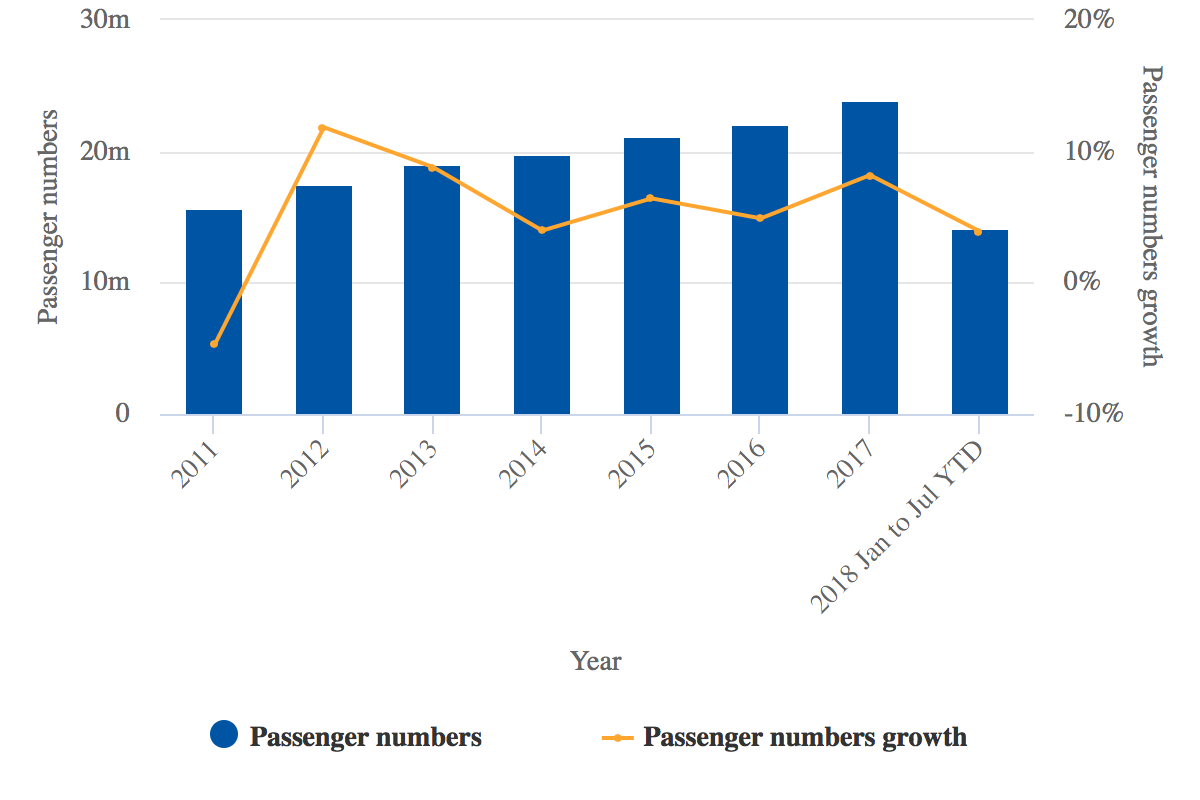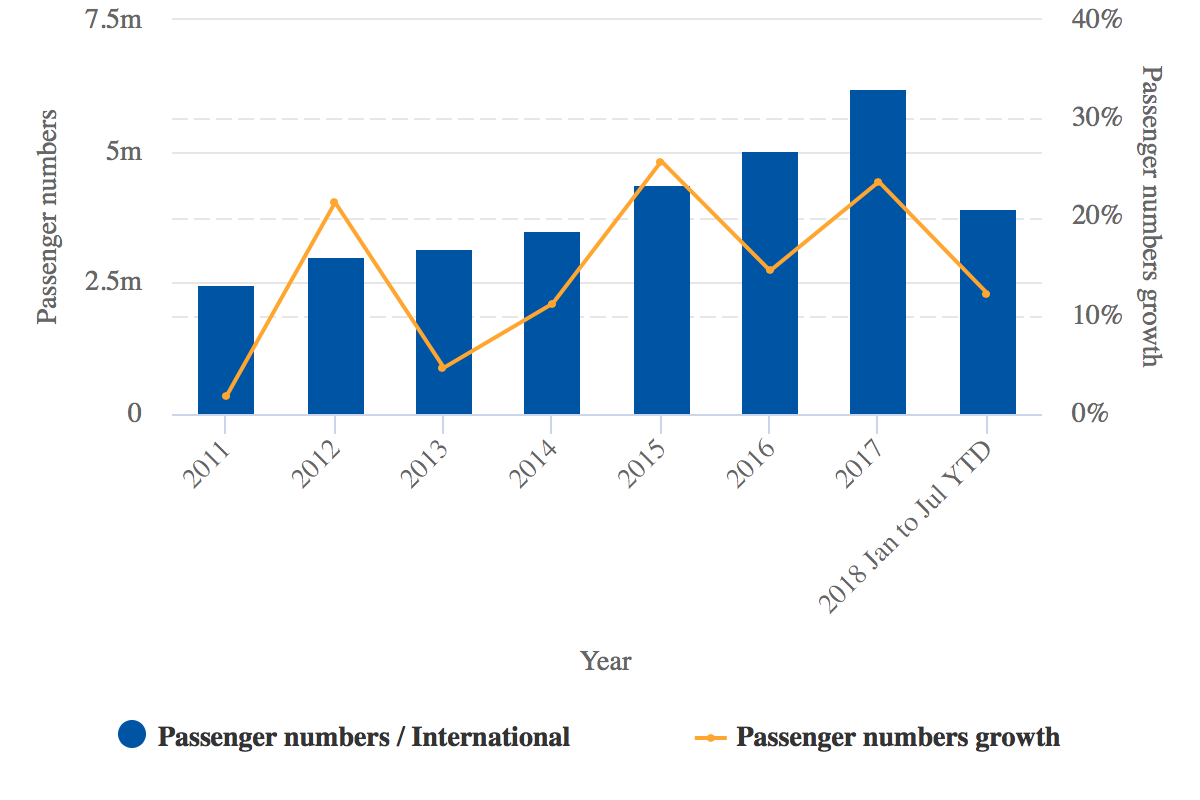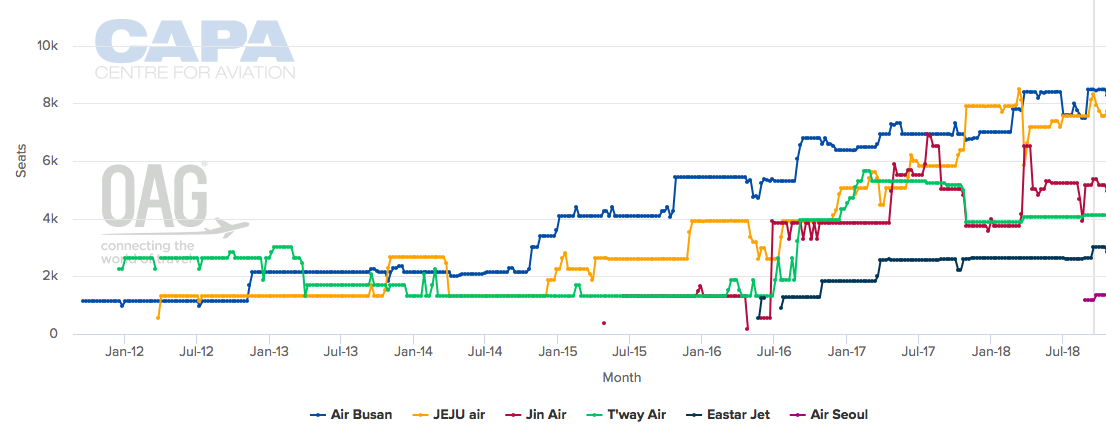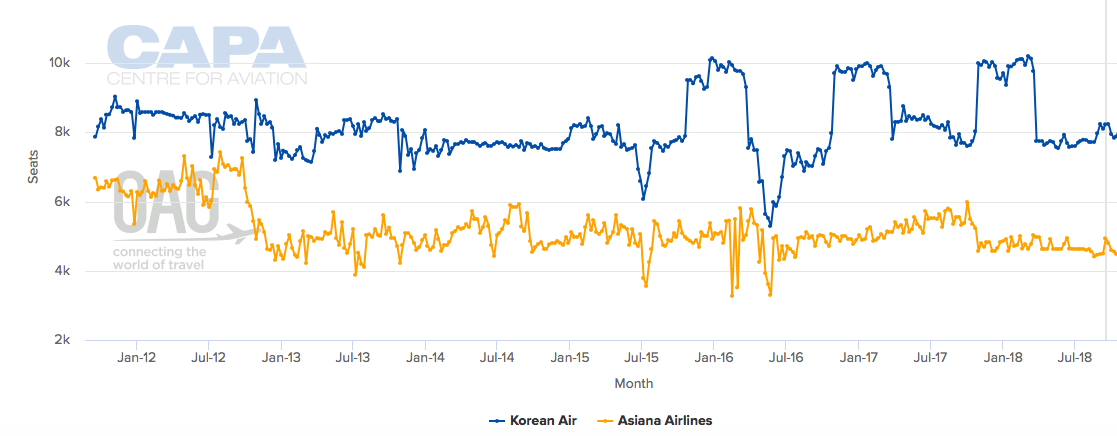Fukuoka Airport: rapid international growth driven by LCCs
Fukuoka Airport has experienced rapid international growth this decade, driven primarily by Korean LCCs. Further rapid international growth is likely as a new consortium takes over operation of the airport and develops a new low cost carrier terminal (LCCT).
The new consortium, which includes three Japanese companies and Singapore's Changi Airport, expects international passenger traffic will increase to 16 million by 2048, compared to close to 7 million in 2018. Domestic passenger traffic, which has grown at a very slow pace this decade, is projected to increase to only 19 million by 2048, compared to approximately 18 million in 2018.
The Fukuoka HD consortium has a target of securing nearly 40 new international routes over the next 30 years, including new long haul routes to Europe and North America. Its plan is to expand the airport's international terminal, as well as to develop a dedicated LCCT to accommodate the anticipated growth.
Summary
- Fukuoka Airport international passenger traffic has more than doubled since 2011 and has grown at a double digit rate in six out of the past seven years.
- A new private consortium is taking over Fukuoka Airport in 2019 and expects further rapid international traffic growth.
- LCCs have accounted for most of Fukuoka's growth in recent years, particularly the Korean LCCs.
- Korea is by far Fukuoka's largest market, with service from eight Korean airlines, including six LCCs.
- The airport's new owners plan to build a low cost carrier terminal (LCCT), which should drive a further increase in Fukuoka's LCC penetration rate.
Japan privatises its fourth largest airport.
In Jul-2018 Fukuoka Airport HD won a bid set by the Japanese government for the takeover and operation of Fukuoka Airport for 30 years from Apr-2019. Fukuoka Airport HD consists of Nishi-Nippon Railroad, Mitsubishi Corporation, Changi Airports International (CAI) and Kyushu Electric Power.
Fukuoka is the fourth largest airport after Tokyo Haneda, Tokyo Narita and Osaka Kansai. It handled 23.8 million passengers in 2017 and 14 million passengers in the first seven months of 2018.
Top 10 airports in Japan ranked by passenger traffic for 7M2018
| Rank | Profile | Code | Passengers |
|---|---|---|---|
| 1 | Tokyo Haneda Airport | HND | 47,306,217 |
| 2 | Tokyo Narita Airport | NRT | 24,308,329 |
| 3 | Osaka Kansai International Airport | KIX | 17,416,419 |
| 4 | Fukuoka Airport | FUK | 13,959,024 |
| 5 | Sapporo Chitose Airport | CTS | 13,528,355 |
| 6 | Okinawa Naha Airport | OKA | 11,992,268 |
| 7 | Osaka Itami Airport | ITM | 9,037,529 |
| 8 | Nagoya Chubu Centrair International | NGO | 6,743,246 |
| 9 | Kagoshima Airport | KOJ | 3,284,261 |
| 10 | Sendai Airport | SDJ | 1,993,248 |
Fukuoka has been one of Japan's fastest growing airports this decade. Traffic has increased by over 50% since 2011, when the airport handled 15.6 million passengers. Growth peaked in 2012 at 12% but has continued at a steady rate. Passenger traffic was up by 8% in 2017 and by 4% in the first seven months of 2018.
Fukuoka Airport passenger traffic and year-over-year growth: 2011 to 7M2018
International traffic triples in 10 years
International traffic has grown at a particularly fast rate. Fukuoka handled 6.17 million international passengers in 2017, compared to only 2.45 million in 2011. International passenger traffic has grown at a double digit rate in six out of the past seven years, including 24% in 2017 and 12% in the first seven months of 2018.
Fukuoka is still mainly a domestic airport. However, international now accounts for nearly 30% of total traffic, by contrast with 16% of traffic in 2011.
Domestic traffic has grown by less than 20% over the past 10 years, whereas international traffic has tripled.
Fukuoka Airport international passenger traffic and year-over-year growth: 2011 to 7M2018
Inbound tourism drives the growth
Fukuoka Airport has benefitted from the regions of southern Japan and Kyushu Island emerging as a popular tourist destination. Overseas visitors to Kyushu increased by nearly 30% in 2017, to 4.8 million, according to the Kyushu District Transport Bureau. Kyushu overseas visitor numbers have increased rapidly since 2014, when there were less than 1.7 million overseas visitors.
Fukuoka also has a large local market (domestic and outbound international) but this segment is relatively mature, whereas the inbound international market has been growing rapidly. Fukuoka's inbound international market exceeded the outbound international market for the first time in 2014, when the airport handled 884,000 foreign arrivals and 838,000 outbound Japanese residents.
Fukuoka is the largest city on Kyushu and the seventh largest city in all of Japan. Fukuoka city has a population of close to 1.5 million, Fukuoka prefecture has a population of 5 million, and Kyushu has a population of approximately 13 million.
Kyushu is a large island (over 300km from north to south) with several airports, but Fukuoka is the only airport with more than 10,000 weekly international seats. Fukuoka currently has more than 150,000 weekly international seats, which makes it the fourth largest international airport in Japan after Tokyo Narita, Osaka Kansai and Tokyo Haneda.
Korean LCCs account for most of the recent international growth
Korea is the biggest source market for Fukuoka and Kyushu tourism. The Korean market has grown rapidly in recent years, driven by rapid expansion from LCCs.
Fukuoka-Korea seat capacity has more than doubled over the past four years - from approximately 17,000 weekly one-way seats in Oct-2014 to 42,000 weekly one-way seats in Oct-2018.
Fukuoka-South Korea total one-way weekly seat capacity: Sep-2011 to Oct-2018
LCCs have accounted for virtually all this growth. FSC capacity in the Fukuoka-South Korea market has been relatively flat over the past four years (with some seasonal fluctuations), whereas LCC capacity has grown sixfold - from less than 5,000 weekly one-way seats in Oct-2014 to 30,000 weekly one-way seats in Oct-2018.
All six of South Korea's LCCs now serve Fukuoka. By capacity, Air Busan and Jeju Air are the largest airlines in Fukuoka's international market. Air Busan operates 42 weekly services to Fukuoka and Jeju Air operates 40 weekly services. Both have more than 8,000 weekly one-way seats to Fukuoka, and each has approximately a 20% share of total Fukuoka-South Korea seat capacity.
Jin Air currently operates 28 weekly services to Fukuoka, T'way Air 22, Eastar Jet 16 and Air Seoul 7. Jin Air is the fourth largest airline in Fukuoka's international market by capacity, and Easter Jet is the eighth largest.
Air Seoul has a small presence as it is the newest Korean LCC and only began serving Fukuoka in late Aug-2018. The five other Korean LCCs have been in the Fukuoka market for at least two years, and have consistently added capacity.
Fukuoka-South Korea LCC one-way weekly seat capacity by airline: Sep-2011 to Oct-2018
Asiana and Korean Air have a large presence but have not grown
Korea's two full service airlines also have a large operation at Fukuoka. Korean Air currently has 35 weekly services to Fukuoka and Asiana has 21 weekly services.
Although Air Busan and Jeju Air have more services, Korean Air has about the same amount of seat capacity, since some of its Fukuoka services are operated with widebody aircraft. Asiana also uses a mix of narrowbody and widebody aircraft in the Fukuoka market.
Korean Air has nearly a 20% share of Fukuoka-South Korea capacity, matching Air Busan and Jeju Air, while Asiana has approximately an 11% share. (Asiana and Korean actually have larger shares as airline groups because Jin Air is under Korean and Air Seoul and Air Busan are under Asiana.)
By capacity, Korean and Asiana are both among the five largest airlines serving Fukuoka's international market (along with Air Busan, Jeju Air and Jin Air). However, Korean has about the same amount of capacity in Fukuoka as it did seven years ago, whereas Asiana has less capacity.
Fukuoka-South Korea LCC one-way weekly seat capacity by airline: Sep-2011 to Oct-2018
Seoul Incheon is Fukuoka's largest international route
Korean airlines dominate Fukuoka's international market, accounting for over half of Fukuoka's total international capacity. No Japanese airline (LCC or FSC) currently serves Korea from Fukuoka.
There are five South Korean cities served from Fukuoka although Seoul is by far the largest, accounting for 65% of total Fukuoka-Korea capacity. Six airlines compete on the Fukuoka-Seoul Incheon route - Air Seoul, Asiana, Eastar Jet, Jeju Air, Jin Air, Korean Air and T'way.
Air Busan serves the Fukuoka-Busan route, along with Jeju Air and Korean Air. Air Busan also competes against T'way on the Fukuoka-Daegu route. Eastar Jet serves Fukuoka-Cheongju and Jeju Air serves Fukuoka-Jeju (both are seasonal only).
Taiwan and China have grown, but not as fast
Taiwan and China are the next largest international markets from Fukuoka and are growing source markets for the local tourism industry.
However, Taiwan and China are relatively small markets compared to Korea, accounting for 14% and 10% of current international seat capacity respectively. They also have not grown nearly as fast as South Korea in recent years. Over the past four years Fukuoka-Taiwan seat capacity has increased by close to 50%, whereas Fukuoka-China capacity has grown by only 30%.
Taipei is the second largest international route from Fukuoka and is served by four airlines - China Airlines (CAL), EVA Air, Tigerair Taiwan and the Japanese LCC Vanilla Air. CAL currently has 17 weekly services on the route and the other three competitors have one daily service. EVA and Tigerair Taiwan also each operate five weekly services between Fukuoka and the second largest Taiwanese city of Kaohsiung.
Fukuoka is currently served from four Chinese cities - Dalian, Shanghai, Qingdao and Yantai. Air China serves the Dalian and Shanghai routes, China Eastern serves Shanghai and Qingdao and the LCC China United serves Yantai.
Hong Kong market grows rapidly but is smaller
Hong Kong is Fukuoka's only major international market. The Fukuoka-Hong Kong route has grown rapidly, more than doubling in size over the past four years - from less than 3,000 weekly one-way seats in Oct-2014 to 7,000 weekly one-way seats in Oct-2018. Hong Kong is currently Fukuoka's fourth largest international market, accounting for approximately 8% of total international seat capacity.
Cathay Dragon and the LCC HK Express have both expanded rapidly. HK Express entered the market in 2014 with seven weekly services and currently has 18 weekly frequencies (a 19th frequency is being added from the end of Oct-2018). Cathay Dragon has also grown, from seven weekly services in Oct-2014 to 18 weekly services in Oct-2018.
Greater China (mainland China, Hong Kong and Taiwan) and South Korea account for an overwhelming 87% of Fukuoka's international seat capacity.
Manila is the only other international route that is served by more than one airline or with more than seven weekly frequencies. Philippine Airlines serves Fukuoka-Manila daily and the Philippine LCC Cebu Pacific operates three weekly services.
The other international routes served from Fukuoka are: Bangkok (seven weekly services from Thai Airways), Hanoi (four to seven weekly services from Vietnam Airlines), Helsinki (three weekly seasonal services from Finnair), Ho Chi Minh (three weekly services from Vietnam Airlines), Honolulu (five to seven weekly services from Delta Air Lines), Guam (seven weekly services from United Airlines) and Singapore (seven weekly services from Singapore Airlines).
Fukuoka aims to attract more long haul services
The airport's new consortium is keen to attract more services to Europe, supplementing Finnair - which has been in the market on a summer-only basis since 2016. Securing a service from a Gulf airline could also help Fukuoka's ambitions to increase European visitor numbers.
Fukuoka is also keen to attract a service to the continental US, which would enable Kyushu to boost American visitor numbers. Honolulu caters almost entirely to outbound Japanese tourists.
While more long haul services are a possibility, clearly most of the growth opportunities are within Asia. North Asia demand continues to grow, and South Korea, Taiwan and China will remain the main source markets for Fukuoka's tourism sector.
New generation narrowbody aircraft open up new opportunities in Southeast Asia
The Southeast Asia market should also experience rapid growth as Fukuoka is well positioned geographically for long haul narrowbody flights. Fukuoka is closer to Southeast Asia than Osaka, Tokyo or Sapporo, making it within range of several potential new Southeast Asian destinations through the use of A320neos or 737 MAX 8s.
For example, Fukuoka could be served in future from Kuala Lumpur (a six-hour flight) by AirAsia X, using A321neos. NokScoot is considering the launch of services from Bangkok to Fukuoka (a five-hour flight), using 737-800s. Scoot could potentially supplement its parent Singapore Airlines on the Singapore-Fukuoka route (a six-hour flight) by using A320neos.
Japanese LCCs may also launch services from Fukuoka to Southeast Asia. Although Japanese LCCs account for 11% of domestic seat capacity at Fukuoka, they account for less than 2% of international seat capacity. Vanilla is the only Japanese LCC operating international services at Fukuoka and has only been in the market since Mar-2018, when it launched a daily service to Taipei.
Vanilla is in the process of merging with Peach, which has a domestic operation at Fukuoka and recently committed to acquiring A321neoLRs to support new long haul routes to Southeast Asia. Jetstar Japan is the largest domestic LCC in Fukuoka and could also operate international services from the city in the future.
LCCs already account for nearly 50% of international capacity at Fukuoka and should drive yet another phase of international growth for Japan's fourth largest airport. The planned LCCT should help attract several new LCCs, as well as more capacity from existing LCCs.




